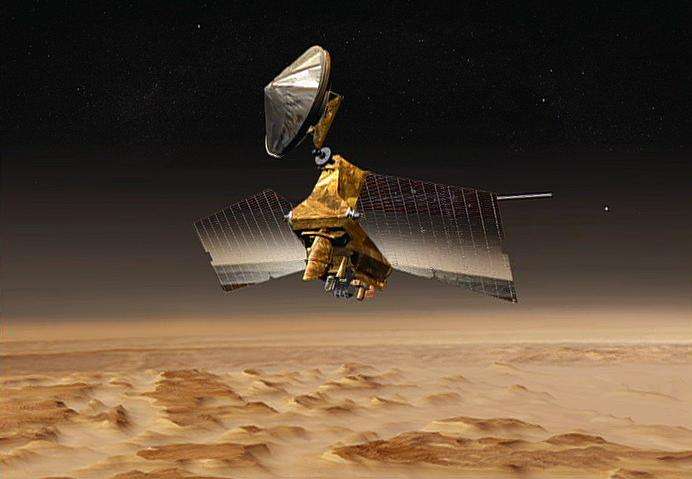Rewrite of onboard memory planned for NASA Mars orbiter

Tables stored in flash memory aboard NASA's Mars Reconnaissance Orbiter (MRO) tell locations of Earth and the sun for the past 10 years, but not their locations next year. That needs to be changed. Carefully.
The long-lived orbiter relies on these tables to recover in the event of an unplanned computer shutdown. When the spacecraft computer reboots, it checks to see where it should position the antenna for communication and, even more critically, where it should position the solar arrays for power. Flash memory is "nonvolatile"—meaning that it retains information even while the power is off—so it works well for this backup role.
The tables were loaded before the spacecraft's Aug. 12, 2005, launch and they cover location information through July 12, 2016. To be safe, the mission team plans to begin updating them next week. Doing so will require intentionally rebooting the onboard computer during a one-week suspension of MRO's science observations and communication relay duty. Both of NASA's active Mars rovers will use a different NASA Mars orbiter, Odyssey, for relaying their data to Earth while MRO is out of service.
Sixteen times since launch, MRO has experienced unplanned reboots that relied on the stored tables for recovery of the spacecraft. Managers anticipate that such events will continue to happen in coming years.
"Updating what's in the memory is essential for spacecraft safety and for extending the mission," said MRO Project Manager Dan Johnston at NASA's Jet Propulsion Laboratory, Pasadena, California.
To update the location tables, engineers will rewrite the entire content of the nonvolatile memory on the spacecraft. The orbiter has two identical computers for redundancy, with only one of them active at a time. Each computer has its own nonvolatile memory unavailable to the other, so the rewrite needs to be done twice. The "Side B" computer has been active since an unplanned side swap in April 2015. The plan is to rewrite that computer's nonvolatile memory starting on Nov. 2. The procedure for "Side A" will follow in early 2016.
The contents of each computer's 256 megabytes of nonvolatile memory include backup copies of vital computer-operation files. "It's the fundamental operating system of the spacecraft. That's what adds risk," Johnston said. "Just like with your home computer: If you mess with the operating system, the computer won't work."
Since MRO launched, the mission team has rewritten the nonvolatile memory just once, in 2009. The Side B rewrite next week will follow procedures similar to those used successfully in 2009, but with an added safeguard. After a partial rewrite, an intentional reboot will be commanded, to confirm that the newly recorded information is usable. If it is not, sufficient information from the 2009 rewrite would still be still available as backup for a successful reboot. After confirmation that the partial rewrite is successful, the rest of the memory contents will be replaced.
Though it is already in its fourth mission extension, MRO could remain a cornerstone of NASA's Mars Exploration Program fleet for years to come. The longevity of the mission has given researchers tools to study seasonal and longer-term changes on Mars, including recently discovered seasonal activity of salty liquid water. Among other current activities, the orbiter is examining possible landing sites for future missions to Mars and relaying communications to Earth from Mars rovers.
Provided by Jet Propulsion Laboratory





















